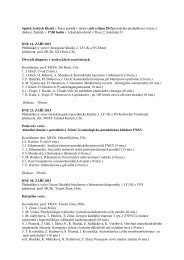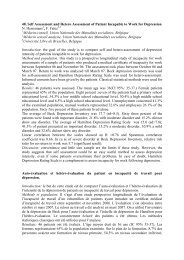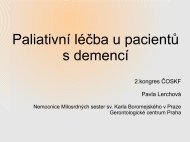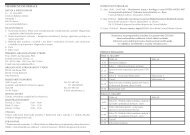ABSTRACTS â ORAL PRESENTATIONS - AMCA, spol. s r.o.
ABSTRACTS â ORAL PRESENTATIONS - AMCA, spol. s r.o.
ABSTRACTS â ORAL PRESENTATIONS - AMCA, spol. s r.o.
You also want an ePaper? Increase the reach of your titles
YUMPU automatically turns print PDFs into web optimized ePapers that Google loves.
progress in development of automated microscopes and specialized image analysis<br />
software opens new possibilities for application of microscopes in high-content (HCS)<br />
and high-throughput screenings (HTS). In this presentation an overview of current<br />
technologies will be introduced including practical experience using three different<br />
automated microscopes currently available in our institute. Automated high-content<br />
measurements are frequently used for evaluations of a wide range of parameters related<br />
to whole cells and/or its parts. Selected commercial and open-source software for image<br />
acquisition and analysis will be briefly introduced. Last but not least, several practical<br />
problems guiding sample preparation and data handling will be discussed.<br />
Acknowledgement:<br />
This work was supported by grant provided by Ministry of the Interior of Czech Republic<br />
No.VG2010201400<br />
70. DOWNREGULATION OF WIP1 PHOSPHATASE MODULATES THE CELLULAR<br />
THRESHOLD OF DNA DAMAGE SIGNALING IN MITOSIS<br />
Jan Benada 1,2 , Libor Macurek 1,2 , Erik Müllers 3 , Vincentius A. Halim 4 , Kateřina Krejčíková 2 ,<br />
Kamila Burdová 2 , Soňa Pecháčková 1,2 , Zdeněk Hodný 2 , Arne Lindqvist 3 ,<br />
René H. Medema 4 and Jiri Bartek 2,5<br />
1<br />
Department of Cancer Cell Biology and 2 Department of Genome Integrity, Institute of<br />
Molecular Genetics, Academy of Sciences of the Czech Republic, CZ14200 Prague, Czech<br />
Republic; jan.benada@img.cas.cz<br />
3<br />
Department of Cell and Molecular Biology, Karolinska Institutet, SE-17177 Stockholm,<br />
Sweden;<br />
4<br />
Division of Cell Biology, The Netherlands Cancer Institute, 1066 CX Amsterdam,<br />
Netherlands;<br />
5<br />
Danish Cancer Society Research Center, Copenhagen, Denmark<br />
Cells are constantly challenged by DNA damage and protect their genome integrity<br />
by activation of an evolutionary conserved DNA damage response pathway (DDR). A<br />
central core of DDR is composed of a spatiotemporally ordered net of posttranslational<br />
modifications among which protein phosphorylation plays a major role. Activation of<br />
checkpoint kinases ATM/ATR and Chk1/2 leads to stabilization of tumor suppressor p53,<br />
which results in a temporal arrest of cell cycle progression (checkpoint) and allows time<br />
for DNA repair (Bartek and Lukas, 2007).<br />
Several key proteins of DDR machinery localize directly to the site of DNA breaks and<br />
form distinct nuclear foci (Lukas et al., 2011). Their number reflects the level of DDR<br />
activation in a quantitative manner. The most commonly used markers of these foci<br />
are phosphorylated histone H2AX (γH2AX) and repair mediator protein 53BP1, which<br />
is recruited as a result of phosphorylation- and ubiquitination-dependent events. To be<br />
able to precisely determine the DDR foci number per cell, we applied the high-content<br />
image analysis approach using automated imaging station Scan^R (Olympus).<br />
Following DNA repair, cells re-enter the cell cycle by checkpoint recovery. Wip1<br />
84 Analytical Cytometry VII








